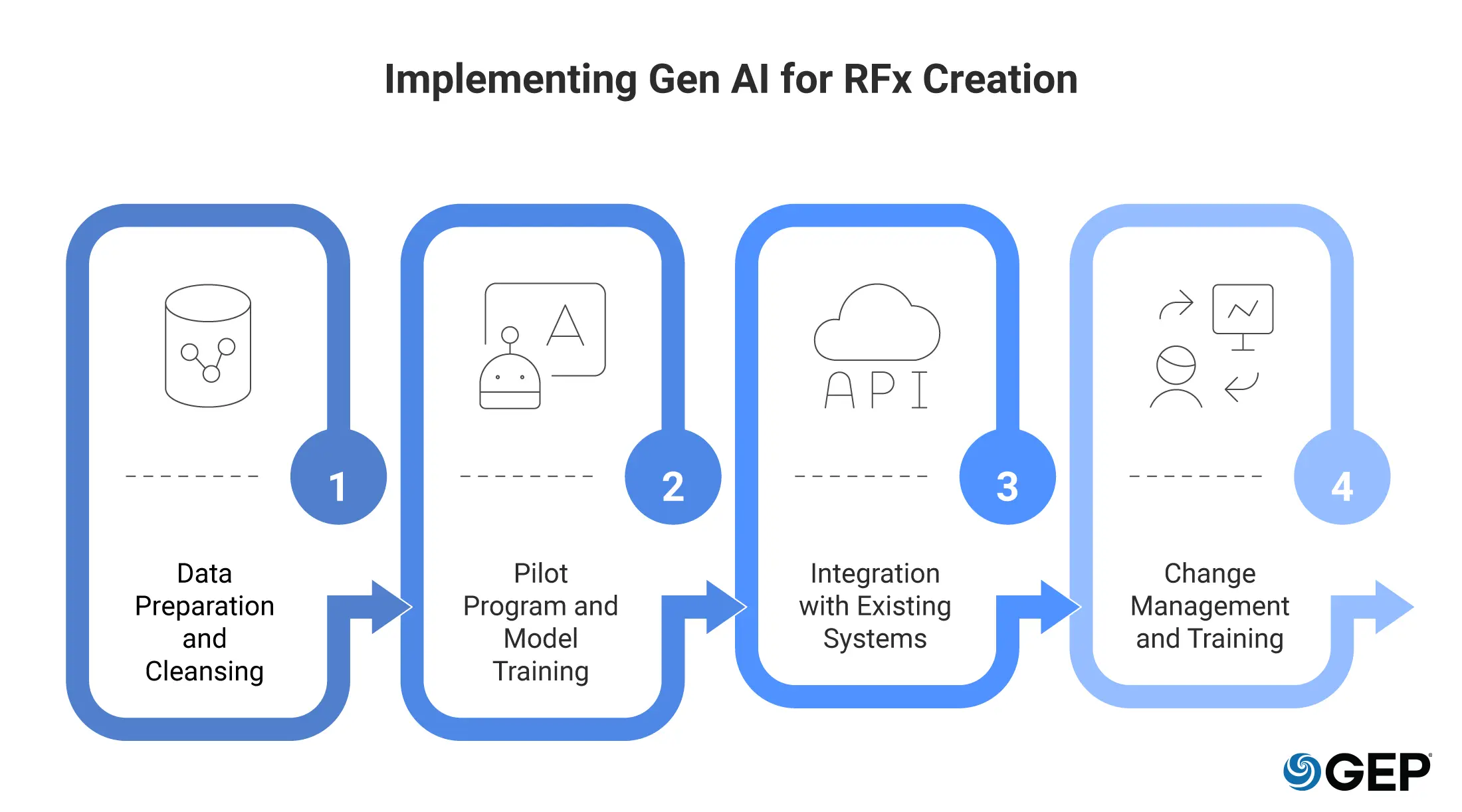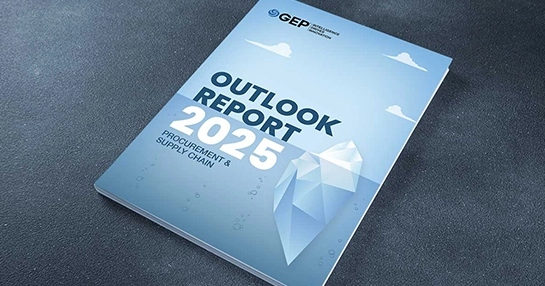
Streamlining RFx Creation with Generative AI Agents
- Generative AI agents use LLMs and advanced analytics to automate drafting, summarizing proposals, and analyzing pricing.
- The technology cuts RFx cycle time and boosts strategic decision-making by providing evidence-based negotiation leverage.
- Successful implementation requires strong data governance (internal systems) and human expertise to supervise outputs and manage compliance risk.
November 04, 2025 | Sourcing Technology 5 minutes read
For years, the RFx process—that's Requests for Information (RFI), Proposals (RFP) and Quotations (RFQ)—has been a major bottleneck for procurement teams. We all know the drill: manual data handling, endless drafting cycles and scattered analysis used to slow everything down.
Generative AI is finally changing all that. AI agents can create new, high-quality content and documents with impressive accuracy. They’re cutting the manual work out while still meeting your stringent standards. The real benefit? Generative AI frees up procurement teams to focus on strategy, not paperwork.
What Is Generative AI for RFx?
Generative AI for RFx uses large language models (LLMs) and advanced machine learning to automate virtually every stage of sourcing.
While traditional AI might categorize your spending or predict which suppliers are at risk, Generative AI can draft an entire RFP from a simple prompt by pulling in details from your historical templates. It's also capable of summarizing complex supplier proposals, standardizing pricing tables, and generating comparison matrices in a snap.
This technology handles the heavy lifting of information generation and analysis, which lets your team shift focus to high-value activities like negotiation and managing supplier relationships.
Gen AI Technologies Used in RFx Creation
Three core technologies make this revolutionary change work:
Natural Language Processing (NLP)
NLP is the AI's ability to "understand" human language. It's how the AI makes sense of a command like, "I need an RFP for cloud services with TIER 3 compliance," and then turns that ask into an actual document. It also lets the AI read through supplier responses, even if they're in different formats, and pull out the specific information you need.
Large Language Models (LLMs)
LLMs train on your company's internal data: old RFPs, contracts, policies, and spending records. After this training, the LLM can write new documents that sound like they came from your team and follow all your company's established rules.
Machine Learning & Advanced Analytics (ML)
ML spots patterns and makes smart recommendations. Say a supplier submits a bid: ML will compare that price against what you've paid historically and what the current market looks like right now.
Steps to Implement Gen AI for RFx
To successfully integrate Gen AI into your procurement function, follow these four crucial steps:
1. Data Preparation and Cleansing
Pull together existing RFx files, contracts, pricing sheets, and policy manuals. Make sure everything is consistently formatted and clean; if you feed the AI garbage, you'll get garbage back. This involves cleansing and standardizing historical RFx and pricing data.
2. Pilot Program and Model Training
Start simple and safe, perhaps with a straightforward hardware RFQ. Train your AI only on that initial area, then compare its output against what your team produces. This is how you learn what works before expanding the program.
3. Integration with Existing Systems
Your new AI system must seamlessly connect with your ERP, procurement tools and finance systems. When the AI can tap into what's happening across the business, it creates better RFx documents.
4. Change Management and Training
Train your team on how to ask the AI effective questions and, critically, how to spot problems in what it generates. The goal is smart supervision: staff must be trained to supervise and utilize AI outputs effectively.
RFx and More: 101 AI Use Cases for Procurement
See How AI Is Transforming Procurement From Source to Pay
Challenges in Using Gen AI for RFx and How to Overcome Them
Here’s how to navigate the common challenges in deploying Gen AI for RFx:
The Accuracy and "Hallucination" Problem
The Challenge: AI sometimes invents facts with confidence. A wrong detail in a technical RFP could lead you to pick the wrong vendor or miss a critical compliance requirement.
The Fix: The inhouse team needs to check everything the AI writes. Look for tools that reference their sources—they should link back to the actual contract or policy they pulled the information from.
Bias Perpetuation
The Challenge: If your company has historically favored large vendors, the AI will learn and perpetuate that preference, potentially sidelining smaller or diverse suppliers without anyone noticing.
The Fix: Actively check your training data for these patterns. Add examples where smaller suppliers succeeded. Crucially, create evaluation criteria that judge suppliers on merit, not just familiarity.
Data Security and Governance Concerns
The Challenge: Sharing sensitive data with outside AI services is risky. Plus, when AI-generated content has mistakes, it's often unclear who is responsible.
The Fix: Run your AI internally or within a private cloud you control to prevent data leakage. Make responsibility clear: people, not algorithms, are accountable for content that goes out. Establish a formal human-in-the-loop review process to ensure all AI-generated content adheres to internal policies and regulatory requirements before it goes to suppliers.
Discover More: AI Powered Sourcing Repository Software
Key Benefits of Generative AI in RFx
Gen AI makes procurement faster and more strategic in drafting RFx, leading to these key benefits:
• Efficiency and Resource Optimization
Gathering specs, getting legal approvals and formatting the final RFP now takes hours, not weeks. This cycle time reduction cuts RFx drafting and evaluation time, ensuring a faster time-to-market. That freed-up time lets your team focus on more strategic, value-added tasks.
• Enhanced Decision-Making
The best AI tools analyze supplier financial health, geopolitical risks and commodity trends, integrating everything into your RFx risk assessment. Because GenAI handles this complex analysis, your team goes into negotiations with evidence-based leverage to secure better terms.
• Consistency and Compliance Assurance
GenAI ensures standardized, high-quality requirements across all RFx outputs. In global organizations, the AI can audit every draft against your policy library and regulatory standards to eliminate human error. This automatic auditing minimizes legal and financial exposure.
AI-Powered RFx Is Essential for World-Class Sourcing
Generative AI for RFx creation is quickly becoming essential for world-class sourcing performance. The speed, precision, and strategic insight it delivers will revolutionize the traditionally slow, manual RFx process.
Remember, Gen AI should augment human capabilities in the RFx process, not replace them. By prioritizing data integrity, establishing strong governance and ensuring human expertise retains final authority, you can navigate the risks and unlock GenAI's full strategic potential for procurement.
Frequently Asked Questions (FAQs)
How does AI-driven RFx creation contribute to cost savings and improved supplier negotiations?
AI-driven analysis of historical and market data can generate highly accurate should-cost models that give your team precise, evidence-based target prices before negotiations begin. That leverage helps secure better contract terms and optimal pricing, translating directly into cost savings.
How do we maintain data security and compliance when utilizing generative AI in procurement?
Use private, dedicated LLMs that only access your organizational data to prevent leakage. Establish a formal human-in-the-loop review process to ensure all AI-generated content adheres to internal policies and regulatory requirements before it goes to suppliers.
What are the key steps involved in implementing generative AI for RFx creation in existing procurement systems?
The key steps in implementing Gen AI for RFx are cleansing and standardizing historical RFx and pricing data, running a pilot program to train the model and validate outputs, integrating the AI model with existing systems, and training staff to supervise and utilize AI outputs effectively.




